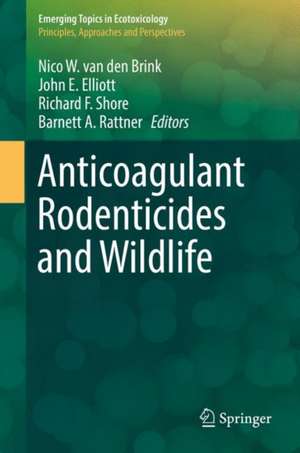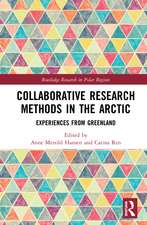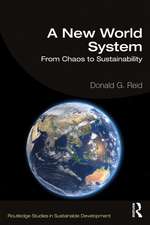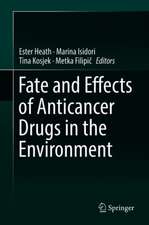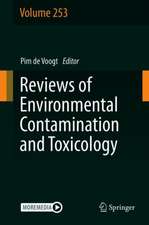Anticoagulant Rodenticides and Wildlife: Emerging Topics in Ecotoxicology, cartea 5
Editat de Nico W. van den Brink, John E. Elliott, Richard F. Shore, Barnett A. Rattneren Limba Engleză Hardback – 22 noi 2017
| Toate formatele și edițiile | Preț | Express |
|---|---|---|
| Paperback (1) | 944.30 lei 38-44 zile | |
| Springer International Publishing – 5 sep 2018 | 944.30 lei 38-44 zile | |
| Hardback (1) | 1228.62 lei 6-8 săpt. | |
| Springer International Publishing – 22 noi 2017 | 1228.62 lei 6-8 săpt. |
Preț: 1228.62 lei
Preț vechi: 1498.31 lei
-18% Nou
Puncte Express: 1843
Preț estimativ în valută:
235.12€ • 255.31$ • 197.50£
235.12€ • 255.31$ • 197.50£
Carte tipărită la comandă
Livrare economică 22 aprilie-06 mai
Preluare comenzi: 021 569.72.76
Specificații
ISBN-13: 9783319643755
ISBN-10: 3319643754
Pagini: 397
Ilustrații: XVI, 398 p. 48 illus., 28 illus. in color.
Dimensiuni: 155 x 235 mm
Greutate: 0.76 kg
Ediția:1st ed. 2018
Editura: Springer International Publishing
Colecția Springer
Seria Emerging Topics in Ecotoxicology
Locul publicării:Cham, Switzerland
ISBN-10: 3319643754
Pagini: 397
Ilustrații: XVI, 398 p. 48 illus., 28 illus. in color.
Dimensiuni: 155 x 235 mm
Greutate: 0.76 kg
Ediția:1st ed. 2018
Editura: Springer International Publishing
Colecția Springer
Seria Emerging Topics in Ecotoxicology
Locul publicării:Cham, Switzerland
Cuprins
Foreword.- 1. Anticoagulant Rodenticides and Wildlife: Introduction.- 2. Use of anticoagulant rodenticides in different applications around the world.- 3. Anticoagulant rodenticide toxicity to non-target wildlife under controlled exposure conditions.- 4. Pharmacokinetics of anticoagulant rodenticides in target and non-target organisms.- 5. Ante-mortem and post-mortem signs of anticoagulant rodenticide toxicosis in birds of prey.- 6. Primary exposure and effects in non-target animals.- 7. Secondary exposure to anticoagulant rodenticides and effects on predators.- 8. Spatial dimensions of the risks of rodenticide use to non-target small mammals and applications in spatially explicit risk modeling.- 9. Ecological factors driving uptake of anticoagulant rodenticides in predators.- 10. Development of resistance to anticoagulant rodenticides in rodents.- 11. An international perspective on the regulation of rodenticides.- 12. Anticoagulants and risk mitigation.- 13. Perspectives on existingand potential new alternatives to anticoagulant rodenticides and the implications for integrated pest management.- 14. Anticoagulant rodenticides and wildlife: concluding remarks.
Textul de pe ultima copertă
Commensal rodents consume and spoil crops and food supplies, cause property damage and can be vectors for disease. Rats have also invaded islands and can pose a serious threat to native wildlife, particularly seabirds. Estimates of rodent damage range into the billions of dollars in developed countries. In southern Asia, rodents are estimated to consume or destroy annually sufficient rice to feed 50 million people. The predominant control method for pest rodents in most countries is anticoagulant rodenticides, which are antagonists of vitamin K metabolism that prevent blood-clotting and cause fatal haemorrhage. This mode of toxicity is common to all vertebrates because of their shared blood clotting mechanism, so anticoagulants pose a potential risk to a wide range of non-target species. This is well recognised and anticoagulants fail regulatory environmental risk assessments in many jurisdictions. Nonetheless, the compounds continue to be heavily used because of the societal need for rodent control and the limited availability of safer alternatives. As a result, exposure of non-target species is commonplace throughout the world and reflects the extensive use, persistence and bioaccumulation potential of many of these compounds. The consequences of such exposure, in terms of effects on wildlife populations, remain uncertain and the subject of much research, debate and controversy. Accordingly, there is a significant and ongoing need for integrated assessment of the threats to wildlife from anticoagulant rodenticides, combined with development of governance, mitigation measures and development of alternatives. This book provides a state-of-the-art overview of the scientific advancements in the assessment of exposure, effects and risks that currently used rodenticides may pose to non-target organisms in the environment. This is discussed in relation to their efficacy, and the societal needs for rodent control, and risk mitigation and development of alternatives.
Caracteristici
This book provides an in-depth yet broad overview on the risks that rodenticides may pose to wildlife, ranging from the biochemical and pharmacokinetic level to ecological field observations affecting secondary exposure Dedicated chapters focus on alternative method for rodent control, including Integrated Pest Management, and on the challenge of development of resistance, with potential implications for their regulation and risk mitigation Consideration of how to detect non-target? rodenticide poisoning in wildlife in the field, and chapters that outline how ecological, landscape and variation in control practices affect exposure and poisoning, make this book not just a scientific overview, but a reference text and a source of practical guidance to scientists, users and even interested members of the public
